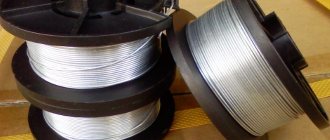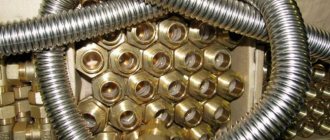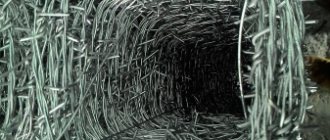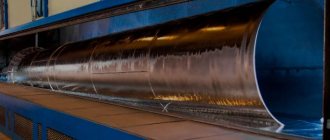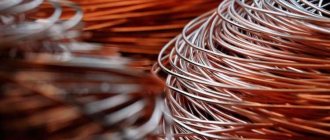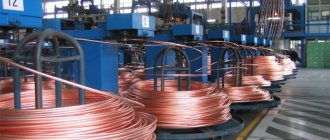Low-carbon knitting wire: properties, features, scope of application
Low-carbon wire, subjected to heat treatment, that is, annealing, in accordance with the requirements of GOST 3282-74 for chemical composition and geometric characteristics, is most often used as a connecting element and is commonly called knitting.
The very concept of wire implies an unregulated length of the product and a diameter that allows it to deform in any direction without irreversible consequences.
Therefore, the diameter of metal wire for the most part falls within the range from 0.5 to 10 mm. From practice, the most popular diameters are 0.8; 1.0 and 1.2 mm. Chemical composition of steels
| Element, % | St 1 kp | St 2 kp | St 3 kp | St 3 ps |
| C (+0.03%) | 0,06-0,12 | 0,09-0,15 | 0,14-0,22 | 0,14-0,22 |
| Mn | 0,25-0,5 | 0,25-0,5 | 0,30-0,60 | 0,40-0,65 |
| Si, no more | 0,05 | 0,05 | 0,05 | 0,05-0,15 |
| R, no more | 0,04 | 0,04 | 0,04 | 0,04 |
| S, no more | 0,05 | 0,05 | 0,05 | 0,05 |
| Cr.no more | 0,30 | 0,30 | 0,30 | 0,30 |
| Ni, no more | 0,30 | 0,30 | 0,30 | 0,30 |
| Cu, no more | 0,30 | 0,30 | 0,30 | 0,30 |
| As, no more | 0,08 | 0,08 | 0,08 | 0,08 |
| Theoretical weight of 1 linear meter of binding wire | ||||
| Diameter, mm | Weight 1 lm, g | |||
| d 1.2 | 8,81 | |||
| d 1.0 | 6,12 | |||
| d 0.8 | 3,91 | |||
Mechanical properties
| Diameter, mm | Time resistance rupture σв N/mm2 (kgf/mm2) | Relative elongation, δ100, % not less |
| Without cover | ||
| 0,20-2,50 | 290-490 (30-50) | 15 |
| St 2.5-10.0 | 20 | |
| Coated | ||
| 0,20-0,32 | 340-540 (35-55) | 12 |
| St 0.32-0.40 | 12 | |
| St 0.40-0.50 | 12 | |
| St 0.50-0.8 | 12 | |
| 0,8-1,0 | 12 | |
| 1,1-1,2 | 12 | |
| St 1.2-2.0 | 12 | |
| 2,2-2,5 | 12 | |
| St 2.5-3.6 | 18 | |
| St 3.6-4.0 | 18 | |
In the process of the birth and development of metallurgy, the initial alloy was not regulated, but as the ore was. With primitive smelting technology, part of the fuel (for example, coal), with which the heating took place, became part of the product itself, giving it various mechanical characteristics, which could not go unnoticed. Carbon, the chemical element from which the bulk of coal consists, getting into the metal, created an alloy with it with a certain crystal lattice and clearly formed strength characteristics (added much-needed hardness and strength). This alloy of carbon and iron, called steel, is well known to every person. It is used everywhere precisely because of the possibility of changing the proportions of the constituent elements in the alloy, which makes it possible to accurately obtain certain required characteristics. To obtain properties such as ductility and softness (which in turn make the knitting process easy and fast without the use of special tools), carbon is added to the wire metal in small quantities, which is why the product is called low-carbon wire.
Welding wire consumption
The consumption of any filler material (including the consumption of welding wire) is determined by the mass of weld deposit. Moreover, the specified mass should be increased by 30-60 percent, making allowances for the diameter and coating (flux) of the piece electrodes.
The resulting weight values are converted into piece or metric values, determining the length of the wire or the number of electrodes. To do this, you need to divide the required mass of filler material by the mass of a linear meter of wire or the mass of one electrode.
Moreover, the quantity of electrodes obtained by welding or piecemeal must be increased by 2-3 percent. This portion will “burn out” during ignition of a broken arc, or during the process of adjusting the welding mode, or during welding of the crater, or for some other, insignificant reason.
Optimizing welding wire consumption
The mass of filler material reaches one and a half percent of the weight of the assembled metal structure. Therefore, an attempt to optimize the welding process and the consumption of welding wire also affects the cost of the finished product.
Moreover, consumption can be optimized in the following ways:
- By increasing the quality of the filler material used. Higher quality (and more expensive) wire guarantees high strength characteristics even with less deposition. For example, the consumption of flux-cored wire during welding is 1.15 kilograms per kilogram of surfacing. But ordinary steel wire of constant cross-section requires at least 1.6 kg per kilogram of surfacing. And the process of welding with flux-cored wire is accelerated by increasing the permissible characteristics of the welding current.
- By changing the scheme for supplying filler material to the weld pool area. Wire consumption during semi-automatic welding is significantly lower than the consumption of filler material during manual welding.
In addition, the welder’s qualifications also affect wire consumption. A competent specialist has fewer errors during the welding process (arc breakage, etc.) and, as a consequence, less loss of filler material.
Method for producing annealed wire
The production process is carried out in several stages. The first stage is the receipt of the workpiece. In this case, the metal undergoes rolling and then drawing, that is, it is drawn without heating, in a cold state. After drawing, the product goes through the final leveling stage. Product quality indicators are established by GOST 3282-74.
Separately, it is worth mentioning the annealing procedure of the product. Annealing is a heat treatment process in which the wire is heated to a certain temperature, held for a while, and then slowly cooled. The purpose of annealing is to transform the product into a more stable state, relieve the internal stresses of the metal that were obtained during cold working, and also improve its structure. Annealing occurs at a temperature of approximately 900 degrees Celsius, followed by slow cooling. Gradual cooling avoids stresses that could lead to cracks. In its finished form, it is a long metal product with a circular cross-section.
Rationing - why is it necessary?
With the help of competent labor regulation, you can increase the productivity of both an individual welder and an entire workshop. Moreover, the main goal of standardization is to maintain high productivity throughout the entire period of work. Therefore, the basis of this process is always related to the physiological capabilities of workers.
That is, in the process of standardization it is necessary to select the optimal intensity (speed) of the welding process. Moreover, the specified speed must be maintained during each work shift.
Simply put: a welder must work the entire shift, completing a certain amount of work, and regain his strength before the start of the next working day.
Then everything is simple: the mass of the deposited metal is calculated based on the intensity (speed). And all other parameters, including material consumption rates, are calculated based on the mass of the surfacing.
Application of Low Carbon Heat Treated Wire
If we use metal as an auxiliary material, then accordingly it should have a low cost. Often in industry, construction and everyday life, there is a need for quick and reliable fixation of various objects, both among themselves and in different spatial positions, with subsequent release without the use of additional fastening systems. In this situation, the most optimal seems to be the use of ordinary knitting wire, which has a low price and availability, consisting of more than 97% iron (a widespread element on the planet with a low cost of production). Also, steel wire with low carbon content is used as a raw material for the production of mechanisms and various meshes: woven, chain-link, welded, etc. A heating wire is made from it, covering ordinary wire with polyethylene (dielectric), and is used in monolithic work to warm up concrete in cold weather, where it remains in the body of the structure forever (the product should also be low cost). Knitting wire is also widely used in everyday life, from paper clips to various types of packaging.
Features and Benefits of Low Carbon Wire
The basis is low-carbon steel wire for general purpose, produced in accordance with GOST 3282-74. An alternative name for tying wire is commercial grade, tying wire, nail wire, or needle wire. This material differs by type of processing: heat-treated and untreated, by surface type: coated, for example, galvanized and uncoated, called “black”.
The diameter of low carbon wire can be in the range from 0.6 to 10 mm. It has high strength due to heat treatment, which is carried out in hermetically sealed bell-type furnaces. For this reason, there is no scale on its surface. The cleanliness and smoothness of the surface is an important advantage: at the end of all stages of production, such wire does not require additional time and money for cleaning it. This significantly simplifies the procedure for applying coatings such as zinc and chromium, and also facilitates the production of mesh and nails based on it, which ultimately reduces the cost, and therefore the price of the product.
In mild steel production, the norm is a carbon content of 0.08% to 0.25% by volume. Due to this, such steel, compared to carbon steel, has a longer service life and is resistant to such phenomena as “metal aging”.
All products have the necessary certificates, passports and permits. The warranty applies for the entire period stated by the manufacturer. After-sales service is carried out in the service centers of our partners and workshops of manufacturers.
Do you want to buy a product at a special price? Are you interested in current promotions and discounts? If you have found an error in the description or have questions about the products presented on our website https://www.Komplektacya.ru, please contact us by contact e-mail: , by multi-channel phone or using the online consultant located in the lower right corner of the page.
Wire
| Our company's warehouses always have various types of steel wire in stock. Our online store presents metal wire produced at the largest metallurgical plants in Russia. |
| Steel wire is a metal product whose length is much greater than the largest cross-sectional dimension. The most common metal wire has a circle in cross-section, but there are types of metal wires that have an oval, trapezoid, hexagon, square and other, more exotic shapes in cross-section. |
Steel wire is divided into groups:
|
| In the warehouses of our company, the most represented types of steel wire are VR-1 wire (BP1) with a diameter of 4 mm and 5 mm, both in coils and in rods 6 meters long. Our company produces welded reinforcing and masonry mesh from this type of wire. This type of product is widely used in construction, finishing and road work. Also from us you can always purchase various types of knitting wire with main diameters from 0.8 mm to 6.0 mm. |
Return to rolled metal catalog
View previous category — View next category—>>
Hexagon prices. Always in stock Galvanized sheets
